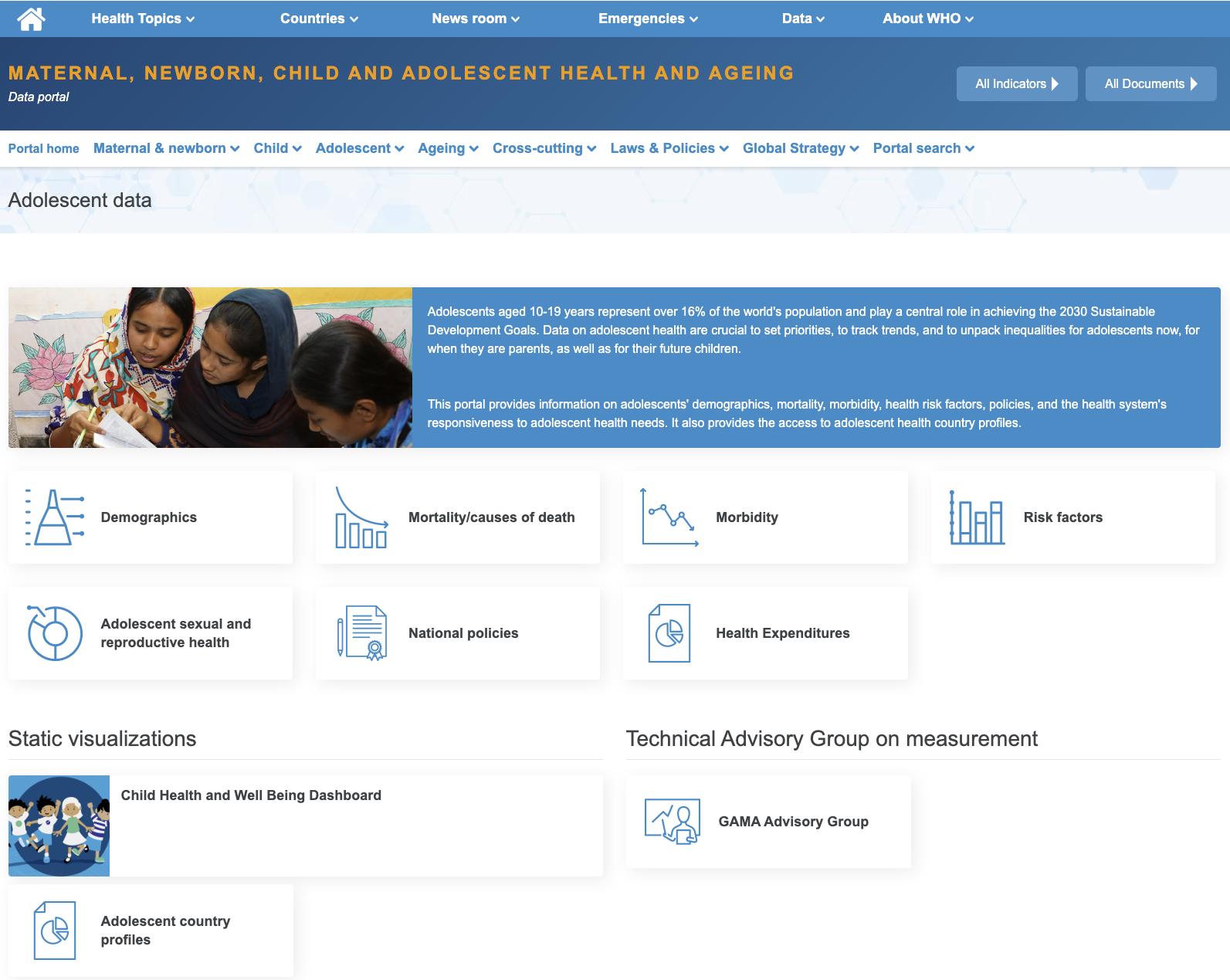
Unintentional injury
Unintentional injuries are the leading cause of death among adolescents. The main categories of unintentional injury include:
- road injuries,
- poisonings,
- falls,
- drowning,
- exposure to mechanical forces,
- natural disasters and fire,
- heat and hot substances.
Violence
Interpersonal violence is the intentional use of physical force or power by one person against another, with a high likelihood of causing injury, death, psychological harm, mal-development or deprivation. It includes all types of physical and/or emotional ill-treatment, sexual abuse, neglect, negligence and commercial or other exploitation. Violence during adolescence can have severe short- and long-term physical, sexual and mental health consequences. Interpersonal violence is among the leading causes of death in adolescents and young people globally, but its prominence varies substantially by region.
Sexual and reproductive health, HIV and other STIs
Contraception, unintended pregnancies and abortion
In many places adolescents cannot easily obtain contraceptives. Even when adolescents can obtain contraceptives, they may lack the agency or the resources to pay for them and knowledge of where to obtain them and how to use them correctly. They may face stigma when trying to obtain contraceptives. In 2019 an estimated 21 million adolescents ages 15–19 years in LMICs had pregnancies, of which approximately half were unintended. Between 2.2 and 4 million of these unintended pregnancies ended in abortions, which are often unsafe in LMICs where abortion is illegal.
Child marriage
Child marriage places girls at risk of pregnancy too young because girls who are married very early typically have limited autonomy to use contraception and delay childbearing. In 2021 there were an estimated 650 million girls and women living who had married before age 18. Despite recent declines in child marriage – from 25% in 2008 to 19% in 2022 of girls being married before age 18 years – there are still about 12 million child marriages every year.
Adolescent birth rate
Globally, the adolescent birth rate has decreased from 65 births per 1000 women in 2000 to 43 births per 1000 women in 2021. Rates of change have been uneven, with the sharpest decline in southern Asia and slower declines in Latin America and the Caribbean and sub-Saharan Africa.
Complications from pregnancy and childbirth
Maternal conditions were the second leading cause of death among adolescent girls ages 15-19 years in 2019, causing seven deaths per 100 000. The rate of maternal mortality in this age group was very high among African low- and middle-income countries, at 20 per 100 000 population, followed by the Eastern Mediterranean, South-East Asia and Americas low- and middle-income countries, at nine, four and three deaths per 100 000 population, respectively.
Gender-based violence
While people of all ages are subjected to gender-based violence, it is particularly common in adolescence. Estimates suggest that one in every five women and one in every 13 men report having been sexually abused before reaching the age of 18.
Female genital mutilation
Female genital mutilation comprises procedures to remove external genitalia partially or totally or otherwise to injure the female genital organs for nonmedical reasons. No form of FGM has health benefits. Female genital mutilation is mostly carried out on girls between birth and age 15 years. The practice is prevalent in 30 countries in Africa and in several countries in Asia and the Middle East, but now it is also present across the globe due to international migration. In 2014, it was estimated that 12 million girls between the ages of 10 and 14 years in Africa have experienced health complications related to female genital mutilation.
HIV
In 2022 at least 1.7 million adolescents ages 10–19 years were living with HIV globally, with adolescent girls constituting 54% of the total estimate. Further, an estimated 140 000 adolescents were newly infected with HIV. Three quarters of these are girls. Only about 65% of adolescents (ages 10–19 years) living with HIV were receiving antiretroviral therapy in 2022 – much lower than the 77% antiretroviral therapy coverage among adults (ages 15+ years) overall.
Other STIs
The incidence of other STIs among adolescents was 7089 per 100 000 population in 2019, with the highest incidence among young adolescents, ages 10–14 years.
Communicable diseases
Five of the top ten causes of death among adolescents are communicable diseases. Along with HIV/ AIDS, the other four are diarrhoeal diseases, tuberculosis, lower respiratory infections and meningitis. These four diseases accounted for more than 200 000 deaths among adolescents in 2019.
Noncommunicable diseases
Noncommunicable diseases (NCDs) are non-transmissible diseases of often long duration, such as mental health conditions, cancers, skin disease, migraine, asthma, stroke, heart disease, diabetes, uncorrected refractive error, hearing loss and oral diseases. Most of the top ten causes of morbidity among the adolescent sex and age groups are NCDs, namely, anxiety disorders, childhood behavioural disorders, depressive disorders, migraine, back and neck pain, uncorrected refractive errors, hearing loss and idiopathic intellectual impairments. Most cases of these NCDs involve mental health.
Mental health
Mental health conditions are among the leading causes of illness and disability among adolescents. The global prevalence of mental disorders is estimated at 13.5% for 10-14 year olds and 14.7% for 15-19 year olds (265). Multiple interlinked social, family and individual factors have an impact on the mental health of adolescents, and the maturing brain is highly susceptible to external influences. Exposure to violence, poverty, stigma, exclusion and living in humanitarian and fragile settings can increase the risk of developing mental health conditions. Increased use of digital technology may also adversely affect adolescents’ mental health. If not addressed, adolescent mental health conditions can extend into adulthood, affecting physical and mental health and limiting opportunities for individuals to participate fully in their communities.

Dr Ivanova, a psychologist, consults with a patient at a health center in Comrat, Moldova (2022).
Our mental health is damaged. We barely have someone to talk to about it without being criticized or called out because we have a certain mental issue. It’s hard to understand someone who grows up without support, but it’s always worth trying. It’s very important for us, as young people who will be ready to take over their roles in the world soon, to be supported by local NGOs, schools or organizations such as WHO and other UN departments.
Alcohol and drug use
Alcohol and drug use among adolescents is a major concern in countries of all income groups. Alcohol and drug use in children and adolescents is associated with neurocognitive alterations, which can lead to behavioural, emotional, social and academic problems in later life.
Tobacco use
The vast majority of people using tobacco today began doing so when they were adolescents. Prohibiting the sale of tobacco products to minors (under 18 years) and increasing the price of tobacco products through higher taxes, banning tobacco advertising and ensuring smoke-free environments are crucial. A global survey including adolescents ages 13 to 15 in 143 countries found that 11.3% of boys and 6.1% of girls reported smoking cigarettes on at least one day in the previous 30 days.
Physical activity and sedentary behaviour
Physical activity provides fundamental health benefits for adolescents, including improved cardiorespiratory and muscular fitness, bone health, maintenance of a healthy body weight and psychosocial benefits. WHO recommends that adolescents engage in a weekly average of at least 60 minutes of moderate to vigorous physical activity per day. This activity may include not only play, games and sports, but also activity for transportation (such as cycling and walking) or physical education. Globally, in 2016 only one in every five adolescents was estimated to meet these guidelines.
WHO guidelines for physical activity and sedentary behaviour also recommend that school-age children and adolescents limit their sedentary time, particularly their recreational screen time.
Nutrition
Some of the key nutrition challenges during adolescence are malnutrition by deficit or excess (that is, undernutrition and obesity) and micronutrient deficiencies (such as deficiencies in iron, vitamin A or iodine). All these important threats to adequate nutrition may relate to socioeconomic circumstances, lifestyle, eating behaviours and underlying psychosocial factors. Many boys and girls in lower-income countries enter adolescence undernourished, making them more vulnerable to disease and early death. Most eating habits detrimental to health are acquired during adolescence and youth and then manifest as health problems in adulthood.



